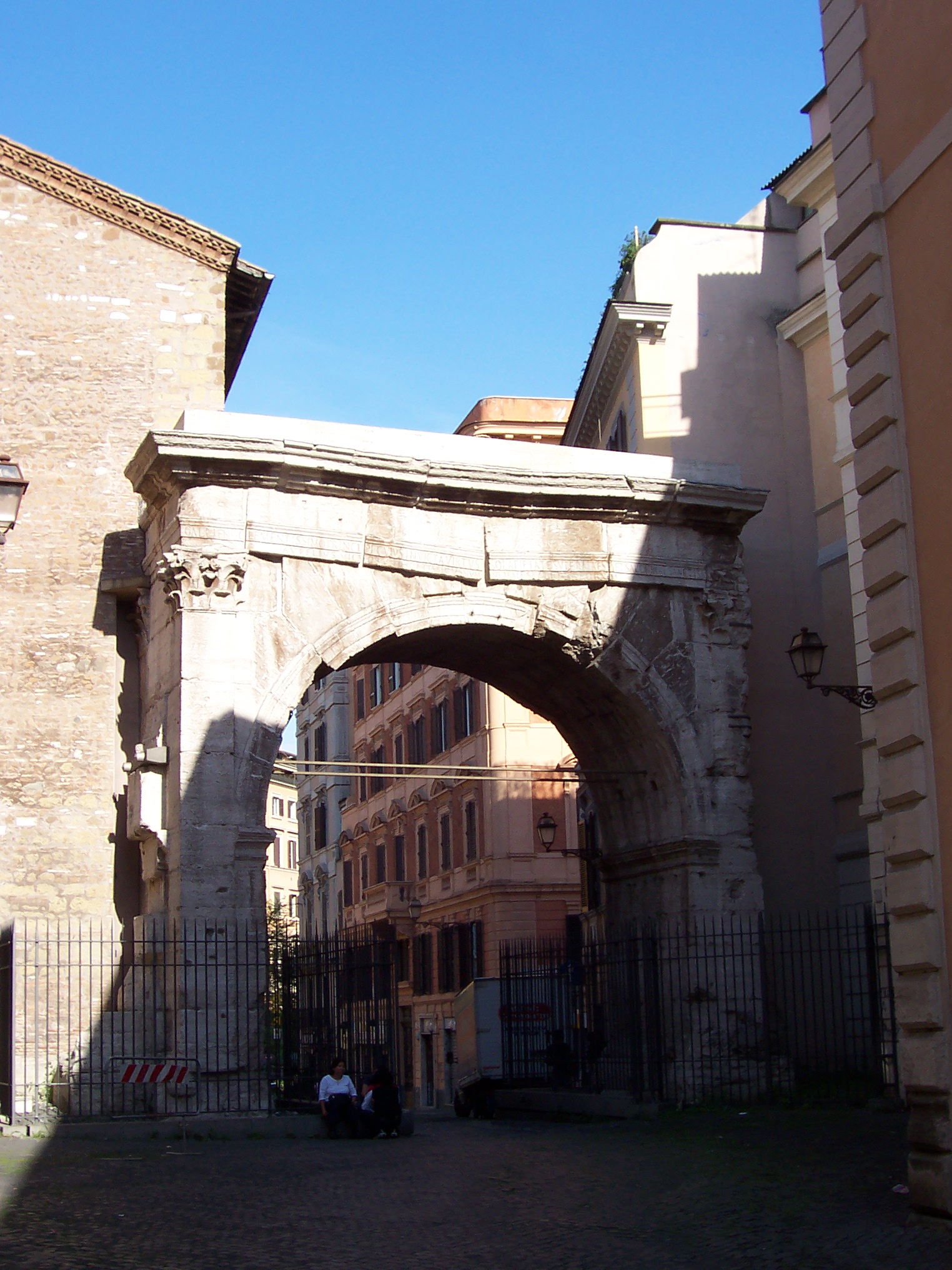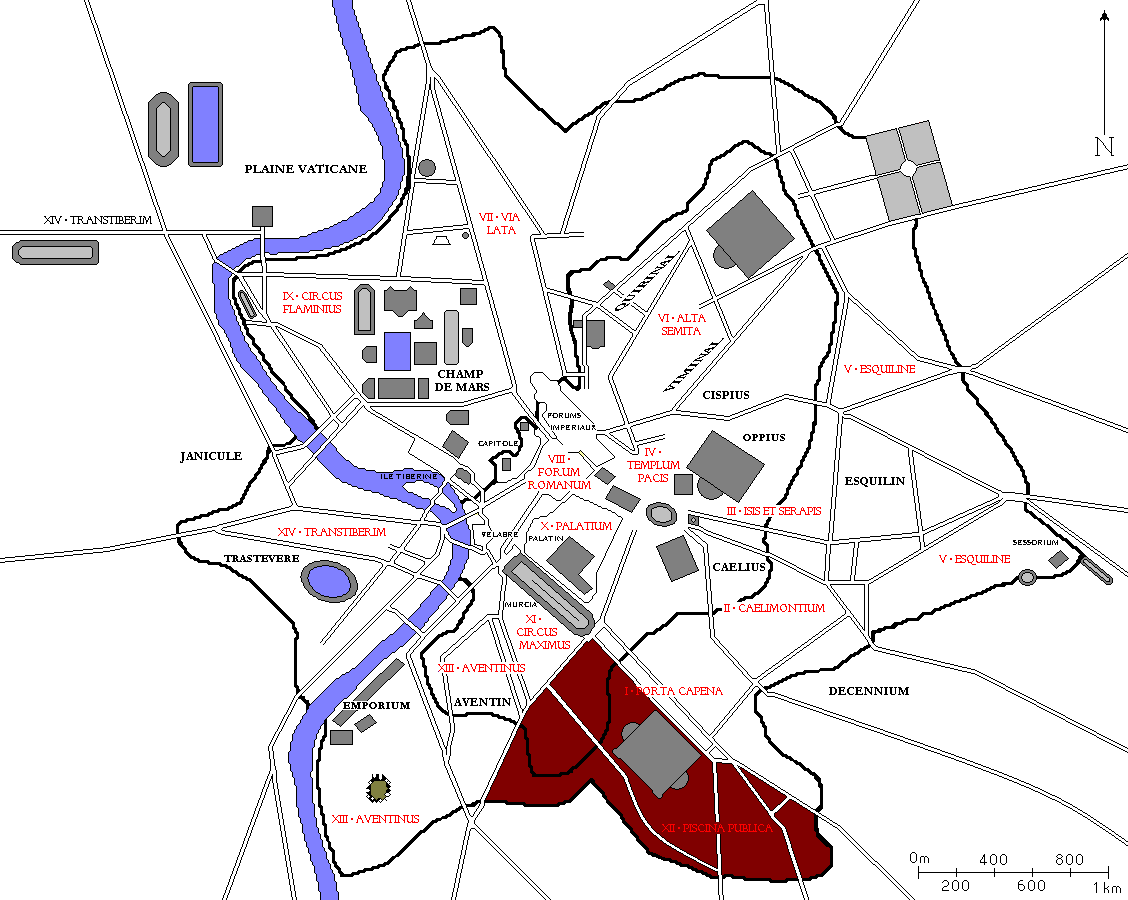|
Porta Naevia ...
The Porta Naevia was a minor gateway in Rome’s Servian Wall. Located in the 12th Augustan region, according to Marcus Terentius Varro’s description the gate was almost certainly situated on the minor summit of the Aventine Hill (''Aventinus Minor''), in between the churches of Santa Balbina and Santa Sabina. The Via Ardeatina emerged from this gate. According to an apocryphal story recounted by the 4th century historian Festus, this gate was supposedly named after a grove called Naevia that had once belonged to a man named Naevius. Over time the grove obtained an unsavoury reputation due to the criminals and homeless people who would frequent the area.Richardson, p. 304 References {{coord missing, Italy Naevia ''Spartacus'' is a set of Starz television series that focuses on the historical figure of Spartacus, a Thracian gladiator who, from 73 to 71 BC, led a major slave uprising against the Roman Republic. Executive producers Steven S. DeKnight and Ro ... [...More Info...] [...Related Items...] OR: [Wikipedia] [Google] [Baidu] |
Ancient Rome
In modern historiography, ancient Rome refers to Roman civilisation from the founding of the city of Rome in the 8th century BC to the collapse of the Western Roman Empire in the 5th century AD. It encompasses the Roman Kingdom (753–509 BC), Roman Republic (509–27 BC) and Roman Empire (27 BC–476 AD) until the fall of the western empire. Ancient Rome began as an Italic settlement, traditionally dated to 753 BC, beside the River Tiber in the Italian Peninsula. The settlement grew into the city and polity of Rome, and came to control its neighbours through a combination of treaties and military strength. It eventually dominated the Italian Peninsula, assimilated the Greek culture of southern Italy ( Magna Grecia) and the Etruscan culture and acquired an Empire that took in much of Europe and the lands and peoples surrounding the Mediterranean Sea. It was among the largest empires in the ancient world, with an estimated 50 to 90 million inhabitants, roughly 20% of t ... [...More Info...] [...Related Items...] OR: [Wikipedia] [Google] [Baidu] |
Servian Wall
The Servian Wall ( la, Murus Servii Tullii; it, Mura Serviane) was an ancient Roman defensive barrier constructed around the city of Rome in the early 4th century BC. The wall was built of volcanic tuff and was up to in height in places, wide at its base, long, and is believed to have had 16 main gates, of which only one or two have survived, and enclosed a total area of . In the 3rd century AD it was superseded by the construction of the larger Aurelian Walls as the city of Rome grew beyond the boundary of the Servian Wall. History The wall is named after the sixth Roman King, Servius Tullius. The literary tradition stating that there was some type of defensive wall or earthen works that encircled the city of Rome dating to the 6th century BC has been found to be false. The main extent of the Servian Wall was built in the early 4th century, during what is known as the Roman Republic. Construction The Servian Wall was originally built from large blocks of Cappellaccio tuff ... [...More Info...] [...Related Items...] OR: [Wikipedia] [Google] [Baidu] |
Regio XII Piscina Publica
The Regio XII Piscina Publica is the twelfth regio of imperial Rome, under Augustus's administrative reform. Regio XII took its name from the ''Piscina Publica'', a swimming pool that disappeared during the middle imperial period. Geographic extent and important features Regio XII was named after the principal feature of this area during the reign of Augustus, the ''Piscina Publica'', a public reservoir and swimming pool, built around the 3rd century BCE. In extent, this region was bordered by the ''Vicus Piscinae Publicae'' to the north, the Via Ostiensis to the west, the Via Appia and the Via Latina to the east, and the Aurelian Walls to the south. Its principal gates through the walls were the Porta Appia and the Porta Ardeatina. A measurement taken at the end of the 4th century recorded that the perimeter of the region was 12,000 Roman feet (approximately 3.5 km), making it one of the smaller of the Augustan regions. The ''Piscina'' itself sat in the low-lying area b ... [...More Info...] [...Related Items...] OR: [Wikipedia] [Google] [Baidu] |
Marcus Terentius Varro
Marcus Terentius Varro (; 116–27 BC) was a Roman polymath and a prolific author. He is regarded as ancient Rome's greatest scholar, and was described by Petrarch as "the third great light of Rome" (after Vergil and Cicero). He is sometimes called Varro Reatinus to distinguish him from his younger contemporary Varro Atacinus. Biography Varro was born in or near Reate (now Rieti) to a family thought to be of equestrian rank, and always remained close to his roots in the area, owning a large farm in the Reatine plain, reported as near Lago di Ripasottile, until his old age. He supported Pompey, reaching the office of praetor, after having been tribune of the people, ''quaestor'' and ''curule aedile''. It is probable that Varro was discontented with the course on which Pompey entered when the First Triumvirate was formed, and he may thus have lost his chance of rising to the consulate. He actually ridiculed the coalition in a work entitled the ''Three-Headed Monster'' ( in th ... [...More Info...] [...Related Items...] OR: [Wikipedia] [Google] [Baidu] |
Aventine Hill
The Aventine Hill (; la, Collis Aventinus; it, Aventino ) is one of the Seven Hills on which ancient Rome was built. It belongs to Ripa, the modern twelfth ''rione'', or ward, of Rome. Location and boundaries The Aventine Hill is the southernmost of Rome's seven hills. It has two distinct heights, one greater to the northwest (''Aventinus Major'') and one lesser to the southeast (''Aventinus Minor''), divided by a steep cleft that provides the base for an ancient roadway between the heights. During the Republican era, the two hills may have been recognized as a single entity. The Augustan reforms of Rome's urban neighbourhoods ('' vici'') recognised the ancient road between the two heights (the modern Viale Aventino) as a common boundary between the new Regio XIII, which absorbed Aventinus Maior, and the part of Regio XII known as Aventinus Minor. Etymology and mythology Most Roman sources trace the name of the hill to a legendary king Aventinus. Servius identifies two ... [...More Info...] [...Related Items...] OR: [Wikipedia] [Google] [Baidu] |
Santa Balbina
Santa Balbina is a Roman Catholic basilica church in located in the Aventine rione, adjacent to the Baths of Caracalla in Rome. History A church at the site initially was built in the 4th century over the house of consul Lucius Fabius Cilo. Possibly the ancient ''Titulus Tigridae'', the basilica was consecrated to St Balbina (died c. 130) in circa the year 600 by Pope Gregory I. It underwent many revisions since then, including by Pope Gregory III in 751, Pope Paul II in 1464, and by Cardinal Pompeo Arrigoni in 1600. Initially affiliated with Augustinians, the allegiance changed to the secular priests of Naples by Pope Innocent XII. The adjoining monastery has a commanding medieval defence tower. Inside the basilica there is a very fine episcopal chair with Cosmatesque decoration from the 13th century. The church was heavily restored in the 1930s when frescoes were discovered on the side walls from the 9th to 14th centuries. The Baroque frescoes in the apse and the triumphal ... [...More Info...] [...Related Items...] OR: [Wikipedia] [Google] [Baidu] |
Santa Sabina
The Basilica of Saint Sabina ( la, Basilica Sanctae Sabinae, it, Basilica di Santa Sabina all'Aventino) is a historic church on the Aventine Hill in Rome, Italy. It is a titular minor basilica and mother church of the Roman Catholic Order of Preachers, better known as the Dominicans. Santa Sabina is the oldest extant ecclesiastical basilica in Rome that preserves its original colonnaded rectangular plan with apse and architectural style. Its decorations have been restored to their original restrained design. Other basilicas, such as Santa Maria Maggiore, have been ornately decorated in later centuries. Because of its simplicity, the Santa Sabina represents the adaptation of the architecture of the roofed Roman forum or basilica to the basilica churches of Christendom. It is especially well-known for its cypress wood doors carved in AD 430-432 with Biblical scenes, the most famous being the first known publicly displayed depiction of the crucifixion of Jesus Christ and the two th ... [...More Info...] [...Related Items...] OR: [Wikipedia] [Google] [Baidu] |
Via Ardeatina
The Via Ardeatina (Ardeatine Way) was an ancient road of Rome leading to the town of Ardea, after which it is named. Ardea lay 24 miles (39 kilometers) distant from Rome , established_title = Founded , established_date = 753 BC , founder = King Romulus (legendary) , image_map = Map of comune of Rome (metropolitan city of Capital Rome, region Lazio, Italy).svg , map_caption ....L. Quilici and S. Quilici Gigli, R. Talbert, Sean Gillies, Tom Elliott, and Jeffrey Becker, 'Via Ardeatina: a Pleiades place resource', Pleiades: A Gazetteer of Past Places, 2020 ccessed: 30 November 2020/ref> Its name is seen in the church of Annunciazione della Beata Vergine Maria a Via Ardeatina. External linksLacus Curtius: Via Ardeatina References Ardeatina, Via Rome Q. XXXI Giuliano-Dalmata Rome Q. XX Ardeatino {{Italy-road-stub ... [...More Info...] [...Related Items...] OR: [Wikipedia] [Google] [Baidu] |
Festus (historian)
Festus (), whose name also appears in the manuscripts of his work as Rufus Festus, Ruffus Festus, Sextus Festus, Sextus Rufus, and Sextus, was a Late Roman historian and proconsul of Asia whose epitome ''Breviarium rerum gestarum populi Romani'' ("Summary of the history of Rome") was commissioned by the emperor Valens in preparation for his war against Persia. It was completed about AD 370. The ''Breviarium'' covers the entire history of the Roman state from the foundation of the City until AD 364. The book consists of 30 chapters treating events in Roman history in terse overview, mainly focused on military and political conflicts. It is estimated as a work of very low quality. Festus of Tridentum, magister memoriae (secretary) to Valens and notoriously severe proconsul of the province of Asia, where he was sent to punish those implicated in the conspiracy of Theodorus. The work itself (Breviarium rerum gestarum populi Romani) is divided into two parts, one geographical, the oth ... [...More Info...] [...Related Items...] OR: [Wikipedia] [Google] [Baidu] |
Nemus
The vocabulary of ancient Roman religion was highly specialized. Its study affords important information about the religion, traditions and beliefs of the ancient Romans. This legacy is conspicuous in European cultural history in its influence on later juridical and religious vocabulary in Europe, particularly of the Western Church. This glossary provides explanations of concepts as they were expressed in Latin pertaining to religious practices and beliefs, with links to articles on major topics such as priesthoods, forms of divination, and rituals. For theonyms, or the names and epithets of gods, see List of Roman deities. For public religious holidays, see Roman festivals. For temples see the List of Ancient Roman temples. Individual landmarks of religious topography in ancient Rome are not included in this list; see Roman temple. __NOTOC__ Glossary A abominari The verb ''abominari'' ("to avert an omen", from ''ab-'', "away, off," and ''ominari'', "to pronounce on an om ... [...More Info...] [...Related Items...] OR: [Wikipedia] [Google] [Baidu] |




_-_Interior.jpg)

